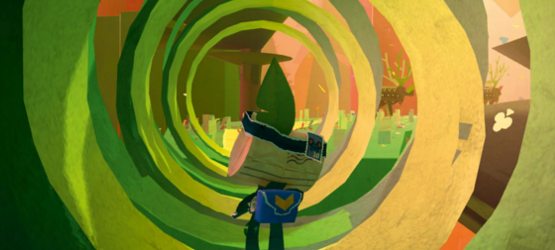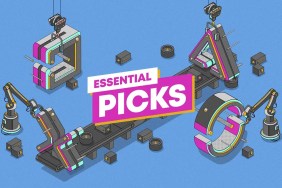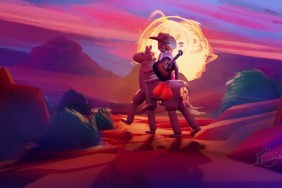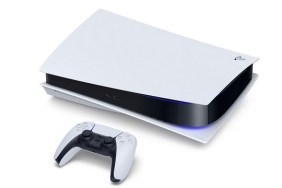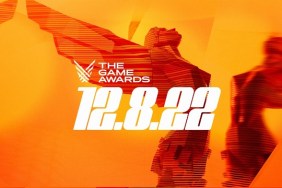We talk to Media Molecule’s Michelle Ducker and James Spafford about the Vita’s biggest upcoming title, Tearaway, as well as the studio’s PS4 project, LittleBigPlanet and a bunch more.
Can you introduce yourselves and explain what your roles are?
M: Hi, I’m Michelle Ducker, producer on Tearaway.
J: And I’m James Spafford, or Spaff, and I’m the community manager for Media Molecule.
So how has the community reacted to Tearaway then?
J: Oh, it’s been amazing. We’ve been releasing papercraft plans to make little guys like the squirrels and the elk and things like that, and even actually before we released them people have started to embrace this world and started to make things out of paper, which is exactly what we wanted them to do. So we take that wonderfully creative community of LittleBigPlanet and show them some more creativity, and they just leap on it, it’s so amazing. We just had a competition to make some squirrels, and if you check our Pinterest all the entries have been amazing.
So what kinds of creativity options do you have in them game?
M: You can customize the characters, you can customize your own character, you can take actual real world textures – like you’ll have missions and challenges where you’ll have a creature that is completely white and blank, and they’ll ask you to customize them and you can take a picture of your foot-
J: – What? [Laughs]
M: I don’t know! Your sofa then, or your friends –
– Or your friends’ feet.
M: Exactly! And then you can use that picture you take with your Vita camera to decorate it.
J: Iota (and the female version of the character Atoi) has a little camera and he can take little in-game almost-like-Instagram pictures with really nice depth of field. So you’ve got this kind of creativity with that camera. Also there’s this virtual cutting mat, so you can take virtual sheets of paper and cut them up and glue them together and make things that you can stick on either your own character or other characters or other things that you meet around the world.
M: And the tools are really simple as well. They’re really easy to get to grips with because we’re kind of in keeping with how it is to create with real scissors and real paper in the real world. We wanted to keep it so that you can create whatever you want, and you can go as complex as you want with it. If you wanted to do super details you could.
J: Which people will. The engine itself is amazing, we spent so much time trying to emulate paper, so it looks like a paper world, but that wasn’t enough for us…
M: It crumples like paper…
J: It feels like paper, it behaves like paper, it curls like paper. That took a lot of effort. Everything that the level designers built in the world starts as a flat sheet of virtual paper that folds out and then builds up, so we know you could make the whole world out of paper if you wanted to, because we made it out of virtual paper.
So how much paper did you use up at the offices then?
J: Piles and piles, reams and reams. Several forests. [Laughs evilly]
M: Of recycled paper! [Laughs] We never throw anything away, it’s full of stacks of paper and little paper craft designs. Our studio is basically a messier version, tenfold, of what we’ve got here [below], but with all different creatures.
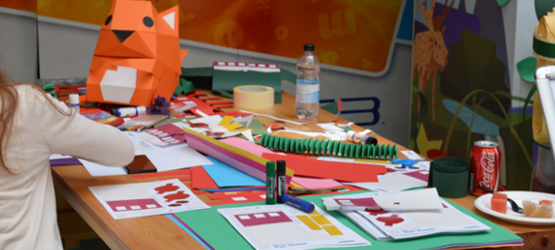
With LittleBigPlanet you had some people that made amazing levels and you offered them jobs because of them. Is that something you could see yourself doing in Tearaway if someone made some amazing papercraft?
J: One of the things we’ve already done is hire a papercraft engineer. We have all these papercraft plans that you can print out and make yourself, that you collect as you go through the game, and we realized how much time and energy it took to just make one of them, we had to seek out a papercraft engineer.
M: The reaction on Twitter ever since we announced the game in August last year was great, we’ve had papercrafters getting in contact with us. And it was just amazing to have touched people in a completely different way to LittleBigPlanet.
Do you think it will be as big as LittleBigPlanet?
J: Who knows, I think it has the potential. LittleBigPlanet is way bigger than any of us thought it would be…
M: It’s a very different game as well.
J: Ooh yeah. This is a very personal game. LBP is about creativity, coming out and sharing it with everyone in the world. This is more about you and Iota going on a journey together, just you and the character on this buddy movie style adventure. So it’s a bit more ‘just for you’, closed.
Is it important to you to try something different?
J: Oh absolutely. We’ve spent almost five or six years working on LBP, so we wanted to stretch and reuse our creative muscles –
M: – Our what? [Laughs] That’s terrible.
J: Sorry! I was just [flexes]… But yeah, we’ve just been doing the same thing for so long, and that doesn’t really suit us. Even working on one game at a time was really hard. Everyone’s so creative and everyone’s got these different ideas.
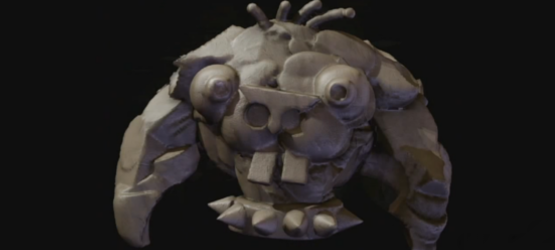
Because this is not the only game you’re working on now is it… [Media Molecule has announced a PS4 title, but have yet to name it or give real details]
J: No it’s not, and for a tiny studio making two games is quite a lot. The Tearaway team is probably about twenty people.
M: There are probably about twenty to twenty five people.
And the other team is?
J: Well the studio is fifty people, but that includes HR and office management.
M: So we have a fairly small team on the other project.
What we saw wasn’t a tech demo, it’s the project, right?
M: Right.
Does Tearaway link to that PS4 project, then? Because they are being developed at the same time…
[Both pause]
J: No, but if it was we wouldn’t tell you.
M: [Laughs] That’s a great answer. I like that.
As a studio, how did it feel to be at the PS4 unveiling?
M: Our directors went out there, and the way that we work is that we’re very much involved in each other’s projects. So it’s very collaborative, even though we’re working on two different projects. There’s an overlap in some ways. Back home at the studio we had people tuning in. We were all basically online getting excited when Alex [Evans] came on stage, and then we saw Rex’s little bit, I don’t know if you noticed it, but there are little references to Tearaway in the video. It was amazing.
Both that PS4 project and Tearaway make use of cameras. Do you think they’re very important at introducing unique types of gameplay?
J: I think when we have hardware features available, we want to use them in as many different and cool ways as possible. With Tearaway, we looked at this handheld and thought ‘what can we make on this?’ And just making a game on the PS3 wouldn’t be interesting to us, why would we do that?
M: We’re making a paper world that you can interact with. What better way than using a back and a front touchpad, and having you able to push your fingers up into the world? No one has really explored using touch in that way. The Vita gives you the opportunity to do that, and that feeling is amazing.
J: And it uses the camera feed so that you can see there’s a hole around your finger. If you hold it up, then it really does look like there’s a hole in the game. Also, when you wave your hand behind it, before you push your fingers through, you can kind of see your hand. It’s like really thin tracing paper. We use it for lots of little bits and pieces – we don’t just use it to bring your face into the game, there are all these other things that we use it for surreptitiously.
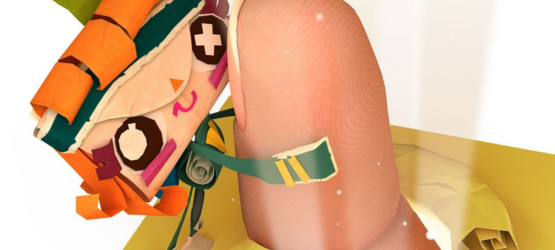
So how did this come about? Did Sony say “here’s a Vita, make a game for it”, or did you look at it and say “we want to make a game for this”?
J: It’s kind of a mixture of both. We’re owned by Sony, so we have the opportunity to see the stuff early, very early prototypes. So the opportunity was there, and Rex was charged with seeing if we could come up with anything good, and we started thinking how strange it would be with the back-touch if you could push your fingers inside, and that’s kind of where the concept was born. Then he thought about the kind of world you’d want to put your fingers inside, and he was like ‘you wouldn’t want to touch horrible cold metal sharp things, or fire, or anything like that. You want to touch things that are nice and tactile.’
Paper is really lovely to touch, and Rex loves playing with paper and drawing and messing about. He’s all about childhood and play. In fact, the whole studio is about that element of play, that creative excitement you have when you’re a kid.
M: It is like a massive playground.
J: It literally is. We’ve just got that new foosball table-
M: -Oh my God! I beat Mark [Healey] at foosball! And we have air hockey.
J: We’ve got a ping pong table too….
Wait, how do you get any work done? I want to play foosball now.
It’s a good way to have breaks. Some people want to have a smoke break, some people have a cup of tea, others will want to play ping pong or lie on a bean bag. If you do stuff other than working, you’re still coming up with ideas, you’re still working through things. You can be in a meeting and play ping pong at the same time. There’s no reason why you can’t be talking about something important and playing foosball.
Sony is undergoing a big culture change with the way they approach third party studios and indie developers. Have you noticed any change as an internal studio?
J: I don’t think so; they’ve always been incredibly open and awesome to work with. Obviously we’ve gone from being a small indie studio to first party, so we’ve seen all manner of different kinds of communication all the way through that, but they’ve always been amazingly supportive, just an absolute pleasure to work with. And I’m not just saying that…
Shuhei’s in the background over there, making sure you say it.
[Laughs] We get so much support from all the other games studios, it really is fantastic.
But Phil Harrison was the one who really brought you into Sony, and now he’s working at Microsoft for the Xbox One.
J: We miss him. I’m glad he’s doing cool things.
He was also at Gaikai, what’s your view on that service?
J: We haven’t really got to use it much yet, but the stuff that I saw at E3 looked really really cool.
Because I’m wondering with a game like your PlayStation Move one, can that still work with streaming and stuff like that?
J: Hmm, I don’t know. We’ll talk more about PS4 stuff at some point. We don’t know when, but soon. For now we’re just desperately trying to finish this game, and we’ve only got a few months left to do it, so it’s all systems go.
Is it worrying that the Vita isn’t exactly selling well?
J: Obviously we care about this stuff, but we’re Media Molecule, and what drives us way more than that is the opportunity to do unique and interesting things, and that’s what excites us. The other stuff is in the background. We trust our PlayStation family to do their best to sell more Vitas, to sell our games, all that cool stuff. What we have to do is just make the best possible product we can, and hopefully that will sell itself.
How long is the average playthrough?
J: I don’t know the actual length in hours, but it’s a good chunk of adventure definitely. And because it’s got so much customization, crazy challenges, and the message is unique to you every time you play through. There’s a bunch of replay value in there so if you didn’t find it long enough you’re still fine. Or if you find it too long then you can enjoy the little crafting bits.
LittleBigPlanet didn’t seem to have much of a single player mode, this seems to have a lot more plot focus.
J: Yeah, with LittleBigPlanet we really focused on create tools, sharing and that whole aspect, and that really drove how we built the play side, because the main purpose of the single player was to teach you. With Tearaway we really wanted to focus on making a story driven game, and we pushed that in an interesting way by having the player be an integral part of the story. As you’re playing through it, the character is aware of you, always looking up at the hole in the sun, and seeing your face looking through, and you form this bond, it’s almost like a buddy movie adventure. We really focused on it being this personal journey, and it’s been really fun to do that instead of having to worry about how polished our tools are.
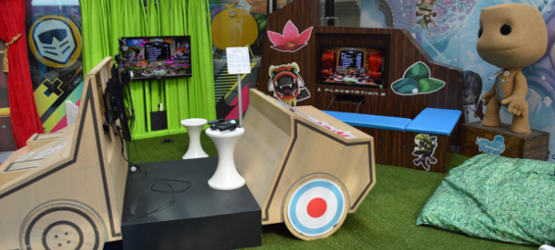
The LittleBigPlanet franchise has been handed off to all these other studios who are working on new titles. Is that something you’re preparing yourself for with Tearaway?
J: [Pauses] We’ve gone through that process, and if Tearaway was to turn into a big franchise probably a similar thing would happen. We always just want to keep making new experiences and new things. At the moment we’re just trying to make this adventure here.
So you’re happy Sumo Digital is doing the next LittleBigPlanet?
J: [Laughs] I don’t know what you’re talking about.
One day that’s going to work, someone’s going to slip up.
J: [Laughs] We’ve… We’ve handed our LBP reigns to Sony, and various studios such as Tarsier, and all the guys who worked on the Vita LBP. We’re so incredibly happy with that, that game is amazing. They’ve captured the spirit of LBP perfectly. Wherever Sony take the franchise next, we know that they know how to do it, and we’re happy.
But whoever it is that might be making it, are you helping them or is that completely out of your hands?
J: Well, whoever it is that might be making future incarnations possibly… we don’t really have time to help them if their existence needed help.
M: From what we’ve seen so far, it’s just so amazing and inspiring. LBP is in capable hands, we’re so proud of what they’re doing.
J: We’ve worked on it for so long that I think if other people work on it they’re going to have ideas that are different to anything that we might have had. Fresh eyes are better, y’know?
M: But it’s really sad though! ‘Oh my god I walked away from it.’
My baby!
M: Right! But it’s reassuring to see what they’ve done.
J: And now we’ve got a new friend [points at Iota].
M: Iota should meet Sackboy! That would be so cute!
So is it important to create a loveable character?
M: That’s an interesting question…
J: I think for Tearaway it is, because the game is very much about you and the character going on an adventure together. If you didn’t have that bond between the character and yourself, then the story just falls apart. You need to be able to think “he’s cool. I really enjoy going on this adventure together.”
The adventure begins on October 22nd in the US and 23rd in Europe. But if you want more from Media Molecule, be sure to read our Daily Reaction special on cheese.
